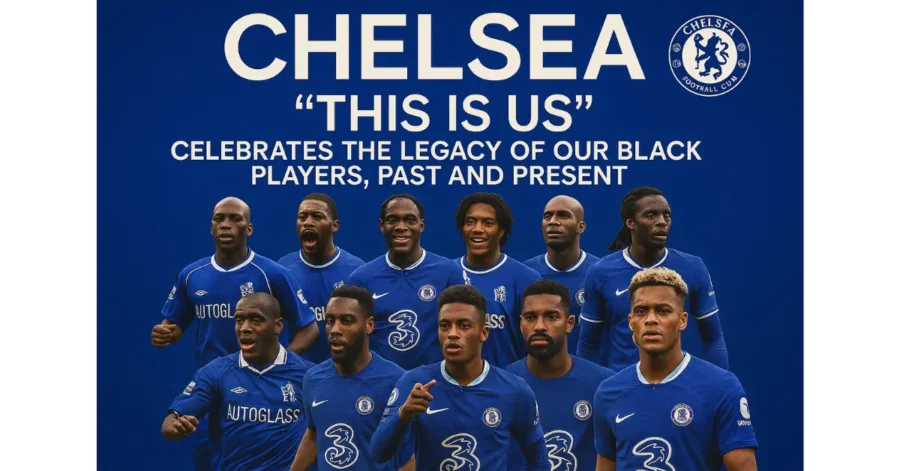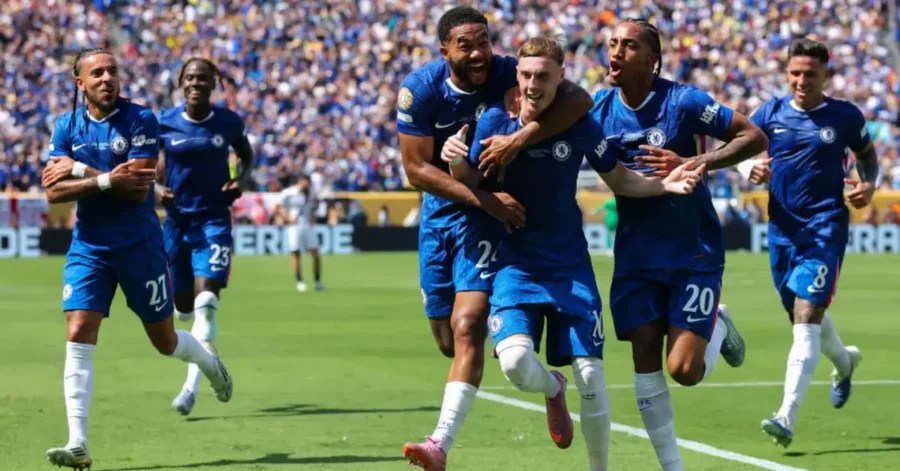
Premier League Chelsea FC Declare: ‘This Is Us’ Celebrates the Legacy of Our Black Players, Past and Present
If you walk past Stamford Bridge on a matchday, the air vibrates with energy and anticipation. Yet, woven into the noise of chanting fans and the rustle of blue scarves is a story that, until recently, was too often left untold—a story of trailblazers who reshaped the club, broke barriers in English football, and paved the way for future stars. Today, Chelsea FC throws open the doors on that history with an initiative both powerful and overdue: “This Is Us.” It’s a celebration, a reckoning, and a showcase of pride—one that honors the contributions of Chelsea black players, past and present, and reminds us that the legacy of Chelsea FC black players is a history worth shouting from the rooftops.
Reflecting on the Past—And Why It Matters Now
It’s tempting to focus only on the present: massive transfers, league table drama, last-minute goals. But if you really want to understand Chelsea Football Club—to know what those blue shirts stand for—you need to look back. Who were the pioneers? Who laid stones on the path that so many others now walk with pride?
The answer isn’t just found in old match reports. It’s in stories like that of Paul Canoville, Chelsea, the very first black player to don the club’s shirt in a time when racism was more than just a headline—it was a hardship lived daily. This was the 1980s, a different world. Being the first often means enduring more than anyone should have to—Paul’s journey was tough, sometimes harrowing, yet ultimately triumphant. His legacy is a foundation; without him, there would be no present to celebrate.
“This Is Us”: More Than a Slogan
This year, as part of Chelsea Black History Month—an event that has quickly grown into a highlight of the club’s social calendar—Chelsea announced, “This Is Us.” But this isn’t a glossy campaign designed for fleeting attention. It’s an education project, a memorial, and a party rolled into one.
At the center lies the This Is Us Chelsea book—pages packed with interviews, rare photographs, and heartfelt reflections. The book is as much about the grit and flair of black footballers in Premier League history as it is about Chelsea specifically. But Chelsea’s lens is unique. Here, we see not just footballers, but mentors, creators, and change-makers.
Zem Clarke: Turning History into Art
When you open the book, you’ll be greeted by stunning artwork from the Zem Clarke artist, Chelsea. Clarke has a knack for bringing out the emotion behind the image—the quiet pride, the struggle, the moments of joy won against a backdrop of adversity. These aren’t static portraits; they practically leap off the page, as if reminding the viewer: these players are more than statistics. They are a movement.
Legends of the Game—The Names That Changed Chelsea
When you talk about Chelsea FC black players making history, a few names have to come to the forefront.
- Paul Canoville: As mentioned earlier, he was the first. Facing racist abuse from both opposition fans and sometimes even his own, his story remains a testament to perseverance.
- Didier Drogba Chelsea legacy: Arguably the greatest modern striker at Stamford Bridge, Drogba’s place in history is enshrined for more than just goals. Who could forget the 2012 Champions League final—a bullet header, followed by the winning penalty, both courtesy of Drogba, leading Chelsea to their greatest ever night?
- Michael Essien: The midfield powerhouse who scored spectacular goals and bossed the center of the park for years.
- Florent Malouda: Whose flair and skill lit up the left wing.
- Claude Makélélé: The man so good they named a midfield role after him.
They are joined by legends from every era, right up to today’s current stars, each of whom stands on the shoulders of those who came before.
Two Perspectives: How the Club and the Community See It
A celebration of this kind will always mean different things to different people. Let’s explore two natural perspectives:
1. The Club Perspective—Learning and Accountability
From Chelsea Football Club’s vantage, “This Is Us” is a way to own the whole story—not just the dazzling matches, but the struggles, the learning curves, and even the past failures to support black players as they deserved.
- The Chelsea Foundation education project now works in schools, sharing these stories so that the next generation learns from the past, rather than repeating it.
- Club officials highlight the public support from figures such as Roman Abramovich, who, beyond his role as owner, made significant contributions to anti-racism initiatives at the club, solidifying a policy of inclusivity off the pitch as well as on.
- The Chelsea FC No To Hate campaign, another cornerstone of the club’s outreach, isn’t just lip service; it funds workshops, fan education, and supports diversity in hiring at all levels.
2. Supporters and Community—Pride and Representation
For many fans—especially those who grew up facing discrimination or feeling like outsiders—seeing black players like Canoville, Drogba, or Essien become icons in blue is both validation and inspiration.
It’s important, too, for young, aspiring players and supporters to see themselves represented at the highest stage—proof that the game respects their talent, their heritage, and their voice. Years ago, it may have been easy to find posters or memorabilia of just a handful of black footballers at Chelsea. Now, kids have a bevy of heroes to choose from.
Breaking Down Barriers: The Impact of Chelsea FC Black Players
What do these players mean to football and to society more broadly? Here are a few ways their impact shines beyond the pitch:
- Changing the Game: From skill and toughness to leadership, Chelsea FC’s black players have altered the way the team plays and the way the Premier League itself is viewed.
- Smashing Stereotypes: Through consistent excellence, they challenge lazy narratives about race and ability.
- Opening Doors: Each new debutant adds a new chapter—and a new permission slip—for others to dream big.
- Community Engagement: Many players, during and after their careers, invest directly in youth projects, charities, and coaching, passing on their knowledge.
What “This Is Us” Teaches Us (and Why It Matters Beyond Chelsea)
The story is larger than blue shirts and roaring Stamford Bridge terraces. “This Is Us” is a reminder of why football remains so much more than a game. Here’s what we take away:
- Resilience Leads to Change: Paul Canoville’s journey wasn’t typical, and it wasn’t easy, but it made things easier for those coming after.
- Diversity Drives Success: The golden periods in Chelsea’s modern history? They coincide with times when the team embraced players from every background.
- Shared History Inspires Future Generations: By documenting the club’s black history, Chelsea provides a beacon to children across London and far beyond.
How You Can Dive Deeper
If this subject tugs at your curiosity (or your conscience), there are a few meaningful ways to get involved or learn more:
- Read the Book: The “This Is Us Chelsea book offers a deep dive into the heart of these stories, with insights, interviews, and one-of-a-kind artwork by Zem Clarke.
- Attend a Chelsea Foundation education event: These are open not just to Chelsea fans but to anyone interested in football, history, and social progress.
- Support No To Hate: This Chelsea FC campaign runs events, workshops, and partnerships far beyond the club—anyone can join.
- Share Your Story: Representation is a two-way street. If you’re a fan, a coach, or a player, your story adds to the tapestry.
Concluding Thoughts—Why We Celebrate, and Where We Go Next
Every club has its legends, but not every club makes the effort to honor the complexity and richness of its past. By putting the spotlight on the achievements and struggles of Chelsea’s black players, the club makes a statement that echoes beyond football: Inclusion isn’t an add-on. It’s the very foundation of progress.
To celebrate Chelsea Black History Month is to say thank you—not just for the goals and the silverware, but for persistence, courage, and the belief that football belongs to everyone. Whether it’s the thunderous goals of the Didier Drogba Chelsea legacy, the groundbreaking resilience of Paul Canoville Chelsea, or the creative expression of Zem Clarke, artist Chelsea, these stories enrich not only Chelsea’s past but the whole tapestry of English and world football.
So, next time you’re at Stamford Bridge or tuning in from halfway across the world, spare a thought for the pioneers in blue. Their legacy is alive every time a new generation steps onto the grass and believes, truly believes, that this game is theirs too.
And perhaps most important: Don’t just read their stories. Speak to them. Share them. Celebrate them—because that’s what true legacy looks like.


